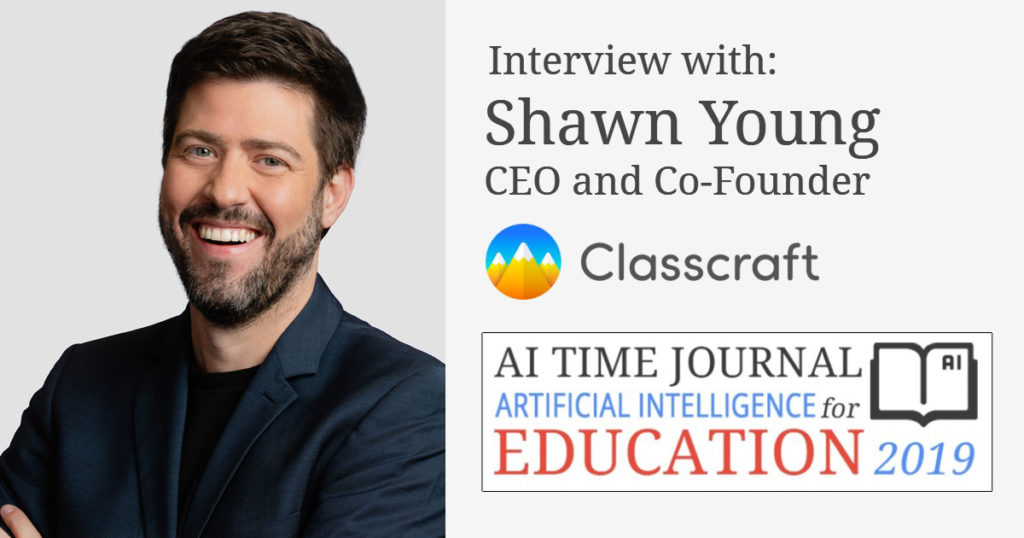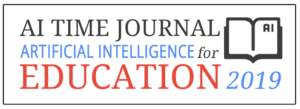
Shawn Young is CEO and Co-Founder of Classcraft, a company that focuses on driving engagement in the classroom and increasing schoolwide collaboration to influence student and teacher success.
In this interview, Mr. Young shares insights on how AI and Machine Learning can impact the learning experience and what are the technical and ethical steps that the educational system management needs to take to start leveraging Artificial Intelligence.
This interview has been
featured in the AI for Education Initiative 2019.

What is Your Background? How was Classcraft started?
Classcraft CEO Shawn Young is a former high school physics teacher who wanted to find a way to make school more meaningful for his students. For Shawn, it wasn’t enough for his students to perform well academically. He wanted them to actually care about being at school — and to care more about each other.
Having researched how online platforms can increase collaboration in real life, Shawn began to see technology’s potential to foster positive interactions in the classroom. More specifically, he began to focus on the power of games, which not only were incredibly popular among his students but were capable of creating the type of sustained engagement that could last throughout the school year.
After implementing a prototype in his own classes, Shawn created a website in January 2013 to outline what he’d created for other teachers. Interest surged, and the site trended on Reddit the next day. By the end of the week, the site had received nearly 250,000 visits.
At the time, in addition to teaching, Shawn was also moonlighting as a web developer for his brother, Devin, a creative director in New York City. Together, they worked on projects for the likes of Chanel, Microsoft, and VC-backed startups. After the surge of interest in what Shawn was doing in his classes, Shawn and Devin decided to found Classcraft to give other teachers the opportunity to make a similar impact in their classrooms. Shortly afterward, the brothers enlisted their father, Lauren, to help with the business side of the venture.
With a grant from the Canadian Media Fund, the Youngs got to work building a beta of the platform. Shawn and Devin teamed up to design and build the platform while Lauren worked to establish the company.
In the five years since launch, Classcraft, now a certified B Corp, has grown to be a team of more than 50 dedicated people. The company has received numerous awards and has grown to serve more than 5 million educators and students in more than 160 countries. Classcraft is available in 11 languages. It offers both a free and premium version of its product to a diverse array of educators from elementary schools to universities.
What is Classcraft’s mission?
Classcraft’s mission is to make school more relevant and meaningful. We work to accomplish this mission by harnessing gaming’s cultural relevance among young people and the power of games to create sustained engagement.
What are the major challenges in the educational system today? How can AI technology help solve or mitigate them?
Dropout rates. Negative school climates. Underdevelopment of non-cognitive skills. Some of the biggest issues in education are rooted in the fact that students don’t want to be at school.
Classcraft helps school districts reach their potential by promoting and measuring motivation in real time. By motivating students at a systemic level, Classcraft helps educators develop students’ soft skills, increase attendance rates, improve grades and test scores, and create happier classrooms. Teachers and administrators use Classcraft data, derived as students are participating in class, to measure how students are developing — not just in terms of academics, but in terms of skills like critical thinking, creativity, collaboration, and communication.
What are the major opportunities brought by AI in Education today?
The biggest opportunity for AI is to make teaching and learning more personal, and to foster real-life connections between teachers and students. AI, in and of itself, won’t solve education’s problems. But it can make educators more powerful. AI and machine-learning technologies have the potential to help administrators identify and influence macro trends and provide “nudges” to students and teachers to make the learning experience more impactful. But to realize the potential of that technology, those who develop it need to have a deep understanding of what educators need to do their jobs better — and the constraints that they work under.
Teachers can get the most out of AI in the classroom by spending time reflecting on how AI can help them accomplish their learning intention for their students.
How can teachers prepare for an AI-powered education?
Teachers can prepare for AI-powered education by learning the right questions to ask when deciding which AI technology to use — or whether they should use one at all. Those questions aren’t about features, benefits, or even data. They’re about the classroom experience that the AI serves to create — which actions are encouraged, and which types of learners are most likely to thrive. And why.
Teachers can get the most out of AI in the classroom by spending time reflecting on how AI can help them accomplish their learning intention for their students. Teachers who start with the end result — the student outcomes they’d like to generate — and then determine how AI can help guide their own practice toward those outcomes will likely see better results than teachers who start with a cool piece of technology and then try to figure out how they can use it in the classroom.
Which AI technology do you think will have the biggest impact in Education in the coming years, and why?
Adaptive learning has become increasingly popular in education over recent years. Its impact will be limited by the relatively narrow scope of what the technology does, but it will certainly see more and more uptake.
The AI technology that will have the greatest impact in education is one that can be responsibly used early in a child’s education, and one that’s capable of understanding kids as human beings and not just collections of competencies. The most impactful AI technologies will be the ones that give teachers more power, not less.
How should educational system management software adapt for the advent of AI?
For educators to reap the biggest benefit from AI technologies, educational system management software must be able to deliver high-quality data that’s of use. Because most of the data contained within education management systems today isn’t usable by AI, that technology must “clean up” existing data and ensure that the new data it records is rich and uniform enough to be leveraged by AI.
Additionally, the way that these systems handle student data and privacy need to become more sophisticated and consistent. This is a hugely important job — and a massive one. I think that this is an area where the ed-tech industry needs to show some leadership by clearly outlining the ethics of how it’s handling student data — and by holding itself accountable to those standards.
Educators also must insist on some level of transparency for how AI technologies work. Because behind every piece of technology is the person who created it. And more often than not, how that technology works is guided by the values of the person who created it. It’s important to know which values and pedagogical intent are behind the technology you’re using.
Finally, IT administrators in educational institutions should insist on only implementing technologies that adhere to open standards. Every school is different, but one thing I can say with confidence is that there isn’t one that only uses technology from one provider. Those systems need to talk to each other.
Do you see threats of inequality in the access to AI-powered education?
With technology in education, access is always an issue that warrants attention. But with AI, the inequality that concerns me more isn’t access, it’s in the experience that AI creates and the outcomes that it delivers.
“Artificial intelligence” is, in large part, the name we give to the process of analyzing data and making recommendations and predictions based on that data. AI is often biased toward patterns that repeat frequently. Algorithms can’t “understand” context, so they’re not great at handling data that looks markedly different from what it’s seen before.
One drawback of AI in education is that much of the data we have is from a time when many social groups didn’t have equal access to education. That leads us to an important question:
Can AI be equitable — or effective — if it’s inherently biased toward well-served social groups? Maybe someday, but today, the answer is that it can’t.
What are the current technological limitations of AI which, once overcome, could bring massive improvements to the educational system?
One specific limitation is the inherent bias of algorithms based on data that doesn’t accurately reflect the world as it exists — that only reflects a past world in which only a few social groups had access to high-quality education.
The nature of the data feeding AI systems in education also presents a technical challenge. The reality is, most AI in education uses data that isn’t very rich — think of something along the lines of a multiple-choice exam. As a result, the AI can only produce a very narrow set of recommendations.
One of the reasons why we decided to develop AI is because Classcraft generates real-life behavior data — such as students’ ability to show empathy, be inclusive, and participate in class. This data is typically hard to gain visibility into and is otherwise very difficult for educators to measure and analyze.
Where do you see AI for education in the next 5-10 years?
Over the next 5-10 years, I think that just about all education companies will employ AI in some form or fashion — likely by licensing it from someone else and bolting it onto their existing technologies.
A few education companies will become truly AI-driven, and a few AI companies will get serious about education. The companies that will be the most successful are the ones who are least likely to broadly proclaim the benefits of AI — and more likely to talk in real terms about how they can enhance interactions between students and teachers, not between students and platforms.
